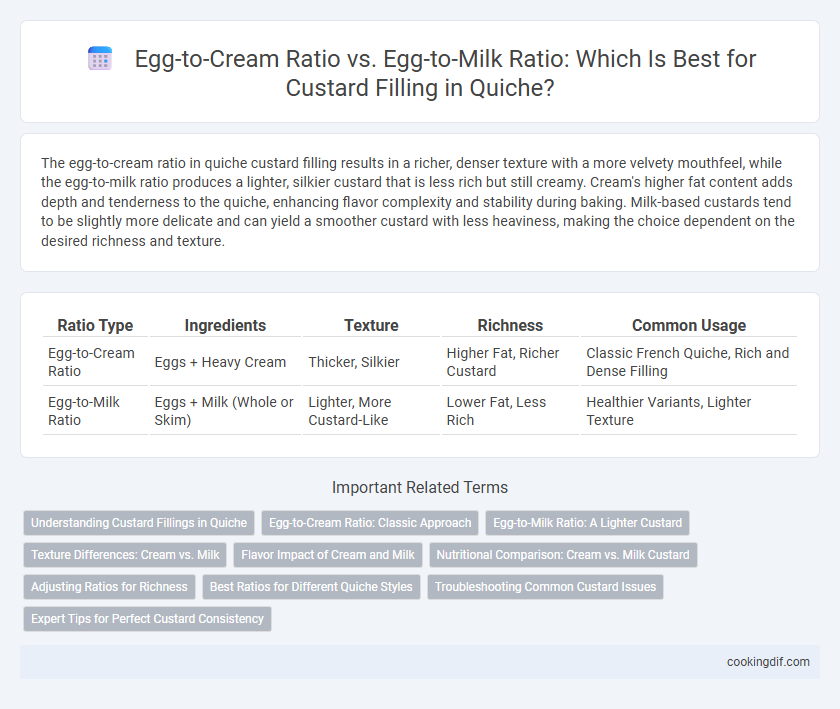The egg-to-cream ratio in quiche custard filling results in a richer, denser texture with a more velvety mouthfeel, while the egg-to-milk ratio produces a lighter, silkier custard that is less rich but still creamy. Cream's higher fat content adds depth and tenderness to the quiche, enhancing flavor complexity and stability during baking. Milk-based custards tend to be slightly more delicate and can yield a smoother custard with less heaviness, making the choice dependent on the desired richness and texture.
Table of Comparison
| Ratio Type | Ingredients | Texture | Richness | Common Usage |
|---|---|---|---|---|
| Egg-to-Cream Ratio | Eggs + Heavy Cream | Thicker, Silkier | Higher Fat, Richer Custard | Classic French Quiche, Rich and Dense Filling |
| Egg-to-Milk Ratio | Eggs + Milk (Whole or Skim) | Lighter, More Custard-Like | Lower Fat, Less Rich | Healthier Variants, Lighter Texture |
Understanding Custard Fillings in Quiche
Understanding custard fillings in quiche involves optimizing the egg-to-cream ratio to achieve a rich, smooth texture, while the egg-to-milk ratio yields a lighter, less dense custard. A typical quiche custard ratio ranges from 3 large eggs to 1 cup of dairy, with cream producing a silkier consistency and milk resulting in a softer, more delicate filling. Balancing these ratios directly affects the custard's firmness, mouthfeel, and flavor depth, essential for perfecting classic French quiche recipes.
Egg-to-Cream Ratio: Classic Approach
The classic approach to quiche custard relies on an egg-to-cream ratio that typically uses three eggs per cup of heavy cream, creating a rich and velvety texture essential for a luxurious filling. This higher fat content from cream enhances the custard's silkiness and stability during baking, resulting in a tender yet firm consistency that holds its shape once cooled. In contrast, egg-to-milk ratios produce a lighter filling that may lack the depth and smooth mouthfeel characteristic of traditional French quiche recipes.
Egg-to-Milk Ratio: A Lighter Custard
The egg-to-milk ratio in quiche custard filling creates a lighter texture by using more milk compared to cream, resulting in a less dense and silkier consistency. This ratio typically ranges from one part egg to two or three parts milk, balancing richness while maintaining a delicate custard that complements savory fillings. Adjusting the egg-to-milk ratio enhances the quiche's overall mouthfeel and prevents heaviness often associated with higher cream content.
Texture Differences: Cream vs. Milk
Egg-to-cream ratio in quiche custard creates a richer, denser texture with a luxurious mouthfeel due to higher fat content. In contrast, an egg-to-milk ratio results in a lighter, silkier custard with a more delicate structure, as milk's lower fat yields a softer, less dense consistency. Balancing these ratios optimizes the quiche's texture, catering to preferences for either richness or lightness in the final dish.
Flavor Impact of Cream and Milk
Using a higher egg-to-cream ratio in quiche custard filling enhances richness and delivers a velvety texture due to the cream's fat content, intensifying the overall flavor profile. In contrast, an egg-to-milk ratio uses less fat, resulting in a lighter, more delicate custard that highlights the eggs' natural flavor without overwhelming creaminess. Balancing these ratios is crucial for achieving the desired mouthfeel and depth of flavor, with cream contributing to a more indulgent taste and milk offering subtlety and refinement.
Nutritional Comparison: Cream vs. Milk Custard
Custard fillings in quiches with a higher egg-to-cream ratio offer richer fat content and increased calories compared to egg-to-milk ratios, which provide a lighter texture with fewer saturated fats. Cream-based custards deliver more vitamin A and fatty acids, enhancing flavor and mouthfeel, while milk-based options contribute more protein and calcium per serving, promoting nutritional balance. Choosing between cream and milk depends on dietary goals, balancing indulgence with nutrient density in quiche fillings.
Adjusting Ratios for Richness
Adjusting the egg-to-cream ratio in quiche custard filling significantly increases richness and creaminess due to the higher fat content in cream compared to milk. Using more cream relative to eggs creates a denser, silkier texture, while a higher proportion of milk results in a lighter, more delicate custard. Ideal ratios vary based on desired texture, with common formulas ranging from 1:1 egg-to-cream for decadent quiches to 1:2 egg-to-milk for a less rich, airy filling.
Best Ratios for Different Quiche Styles
The optimal egg-to-cream ratio for custard filling in quiche typically ranges from 1:1.5 to 1:2, offering a rich, velvety texture ideal for classic quiche Lorraine. In contrast, an egg-to-milk ratio of 1:3 or higher yields a lighter, silkier custard suited for vegetable or herb-focused quiches. Adjusting ratios allows bakers to tailor the quiche's firmness and creaminess, balancing richness with moisture depending on the desired style.
Troubleshooting Common Custard Issues
A balanced egg-to-cream ratio in quiche custard filling offers a richer, silkier texture compared to egg-to-milk ratios, which tend to be lighter but may cause a thinner, less stable custard prone to curdling or weeping. Common custard issues like a rubbery texture arise from excess eggs, while too much milk can lead to watery filling and improper set. Adjusting the egg-to-dairy ratio and ensuring thorough mixing without overbeating prevents separation and ensures a smooth, creamy quiche custard.
Expert Tips for Perfect Custard Consistency
An ideal egg-to-cream ratio for quiche custard filling typically ranges from 1:1 to 1:1.5, producing a rich, silky texture with a balanced density. Using an egg-to-milk ratio of 1:1.5 or higher results in a lighter, more tender custard but may lack the luxurious mouthfeel that cream provides. Expert tips recommend adjusting these ratios based on desired firmness and flavor intensity, ensuring the custard sets perfectly without curdling or becoming rubbery.
Egg-to-cream ratio vs egg-to-milk ratio for custard filling Infographic

 cookingdif.com
cookingdif.com